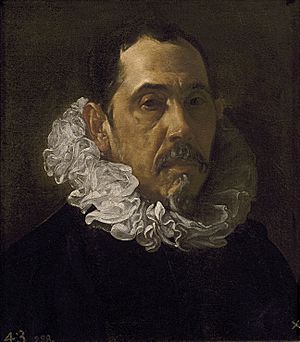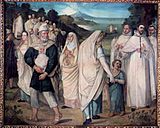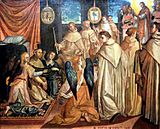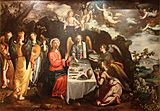Francisco Pacheco facts for kids

Francisco Pacheco del Río (born in 1564, died in 1644) was an important Spanish painter. He is best known for being the teacher and father-in-law of the famous artist Diego Velázquez. Pacheco also taught another well-known painter, Alonzo Cano. He wrote a very important book about painting called Art of Painting. This book helps us understand how artists worked in Spain in the 1600s. Some people called him the "Vasari of Seville" because he loved to share his ideas about art and other painters.
Contents
Pacheco's Early Life and Training
Francisco Pacheco was born in a town called Sanlúcar de Barrameda. When he was young, his family moved to Seville. He studied art with a teacher named Luis Fernandez. Pacheco learned a lot by copying paintings made by famous Italian artists.
In 1611, he traveled to Madrid and Toledo. There, he studied the works of another great painter, El Greco. After his travels, Pacheco returned to Seville and opened his own art school. He married a woman from the de Miranda family. They had one daughter, Juana Pacheco.
Pacheco's Art Career and School
Pacheco's art school focused on painting religious subjects correctly. This was important because he was also an official censor for the Spanish Inquisition in Seville. The Inquisition was a powerful religious court. His own paintings show these rules. For example, his works like Last Judgment and Martyrs of Granada are very large. However, they are not known for being very creative.
Diego Velázquez was a student in Pacheco's school for six years. Velázquez later married Pacheco's daughter, Juana, in 1618. Even though Velázquez studied with Pacheco, Pacheco's style did not greatly influence Velázquez's art. However, Pacheco did teach Velázquez about proper ways to show religious scenes, such as the Immaculate Conception.
Pacheco's Important Book on Art
Pacheco's book, Arte de la pintura (published in 1649), is a valuable resource. It includes information about iconography (the meaning of symbols in art). It also talks about the materials and techniques artists used. The book even shares helpful details about other Spanish painters of that time.
Gallery
See also
 In Spanish: Francisco Pacheco para niños
In Spanish: Francisco Pacheco para niños












